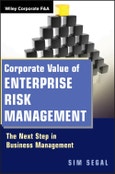The first book to introduce an emerging approach synthesizing ERM and value-based management, Corporate Value of Enterprise Risk Management clarifies ERM as a strategic business management approach that enhances strategic planning and other decision-making processes.
- A hot topic in the wake of a series of corporate scandals as well as the financial crisis
- Looks at ERM as a way to deliver on the promise of balancing risk and return
- A practical guide for corporate Chief Risk Officers (CROs) and other business professionals seeking to successfully implement ERM
ERM is here to stay. Sharing his unique insights and experiences as a recognized global thought leader in this field, author Sim Segal offers world-class guidance on how your business can successfully implement ERM to protect and increase shareholder value.
Table of Contents
Foreword ix
Preface xi
Acknowledgments xix
Part I: Basic ERM infrastructure
Chapter 1: Introduction 3
Evolution of ERM 4
Basel Accords 4
September 11th 5
Corporate Accounting Fraud 7
Hurricane Katrina 9
Rating Agency Scrutiny 10
Financial Crisis 11
Rare Events 13
Long-Term Trends 14
Challenges to ERM 15
Summary 16
Notes 16
Chapter 2: Defining ERM 18
Definition of Risk 18
Definition of ERM 24
Summary 58
Notes 59
Chapter 3: ERM Framework 61
Value-Based ERM Framework 63
Challenges of Traditional ERM Frameworks 63
Value-Based ERM Framework 65
Overcoming the Challenges by Using a Value-Based
ERM Framework 83
Summary 109
Notes 110
Part II: ERM Process Cycle
Chapter 4: Risk Identification 113
Components of Risk Identification 113
Five Keys to Successful Risk Identification 114
Risk Categorization and Definition 114
Qualitative Risk Assessment 129
Emerging Risk Identification 153
Killer Risks 155
Summary 166
Notes 167
Chapter 5: Risk Quantification 168
Practical Modeling 169
Components of Risk Quantification 174
Calculate Baseline Company Value 174
Quantify Individual Risk Exposures 185
Quantify Enterprise Risk Exposure 207
Summary 223
Notes 224
Chapter 6: Risk Decision Making 226
Defining Risk Appetite and Risk Limits 227
Integrating ERM into Decision Making 239
Summary 269
Notes 270
Chapter 7: Risk Messaging 271
Internal Risk Messaging 271
External Risk Messaging 280
Summary 292
Notes 293
Part III: Risk Governance And Other Topics
Chapter 8: Risk Governance 297
Focusing on Common Themes 298
Components of Risk Governance 298
Roles and Responsibilities 298
Organizational Structure 319
Policies and Procedures 325
Summary 327
Notes 327
Chapter 9: Financial Crisis Case Study 329
Summary of the Financial Crisis 330
Evaluating Bank Risk Management Practices 332
Summary 342
Notes 343
Chapter 10: ERM for Non-Corporate Entities 344
Generalizing the Value-Based ERM Approach 344
Complexities of Objectives-Based ERM 350
Examples of NCEs 351
Summary 369
Conclusion 369
Notes 369
Glossary 371
About the Author 389
Index 391








